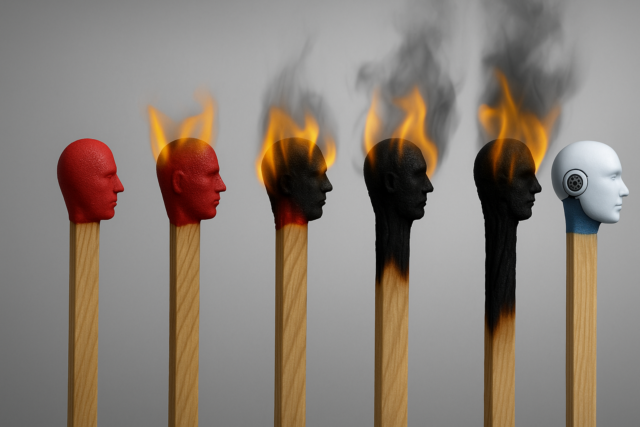The modern workplace has a burnout problem: Is AI the remedy?

Burnout has long been an issue in the workplace, made worse by today’s “always on” culture. In fact, data shows that 77 percent of employees report feeling burned out.
If left unchecked, not only will it lead to health consequences, but also negatively impacts business outcomes. For instance, burnout often worsens employee performance and creates talent retention challenges if morale becomes too negative.
In response, many organizations have launched wellness programs, offered flexible work options, and encouraged better work-life balance. But one key factor remains overlooked: the role of workplace technology.
As AI becomes more embedded in business operations, IT and business leaders are in a unique position to influence how that technology affects employee well-being.
However, this can oftentimes be a double edged sword, and businesses must take caution to choose the right solutions to improve burnout, not worsen it.
IT Leadership’s Role in Reducing App Fatigue + Burnout
With 64 percent of organizations planning to increase IT budgets in 2025 – and AI leading that growth – the tools selected today will have long-term impact. The challenge isn’t just about choosing new tools. It's about choosing the right ones.
Many AI platforms claim to improve productivity. Yet when these systems operate in isolation, they create more problems than they solve. It’s important for IT leaders to sort through the “hype” and ensure that the solutions they are choosing actually move the needle on the organization’s core challenges. For instance, many AI tools claim to improve productivity but very few solutions are actually able to connect all of the dots between various departments.
Another growing contributor to burnout is app fatigue. The average employee uses 11 different applications each day, and high-performing professionals often manage even more. Almost half (47 percent) of digital workers struggle to find the information needed to effectively perform at their jobs. And this constant toggling between tools leads to cognitive overload.
Think about it this way: Some businesses use Slack, Gusto, and Asana to help their employees. Each of these platforms has its own separate AI integration and none of them talk to each other -- which means managers have to manually share information between platforms. It’s easy to see how in this circumstance the use of AI could potentially create even more work for managers -- worsening instances of burnout.
Now imagine a scenario where a centralized AI tool could orchestrate how these platforms communicate with one another, cutting out the need for human busywork and saving valuable company dollars. Workflow fragmentation doesn’t just slow teams down. It erodes focus, adds unnecessary stress, and makes even routine tasks more complicated than they need to be. By implementing AI solutions that provide a unified access point to relevant systems, organizations can streamline information flow and create space for more meaningful, rewarding work.
However, reducing app fatigue is only part of the equation. If done haphazardly, bringing AI into the fold of existing workflows can create its own kind of stress. Many employees feel anxious about how automation will affect their roles, and concerns about job displacement or shifting responsibilities can create resistance if not addressed.
This is why clear communication is essential. Company leadership should explain how new tools will support, and not replace, employees. Setting expectations, offering transparency, and linking new systems to tangible benefits can ease fears and boost engagement. While AI is poised to eliminate repetitive tasks, that promise must be communicated clearly and consistently to gain employee trust.
Shifting Burnout to Job Satisfaction
Beyond alleviating burnout, agentic solutions create space for employees to engage in work that is more fulfilling and aligned with their strengths. It’s a catch-22.
As employees spend less time on mundane tasks, they can dedicate more energy to creative, strategic, and high-impact work that not only drives business success but also enhances personal job satisfaction. And satisfied employees are more engaged and motivated, leading to higher productivity levels. They complete tasks faster, on time, and to the best of their ability.
Not to mention, higher job satisfaction often equates to lower turnover rates. Increased employee retention reduces the need for hiring and training new staff. It also helps avoid disruptions in a company’s operations, ultimately saving organizations money while boosting workforce continuity and stability.
The Path Forward
Burnout is no longer just a workforce challenge. It is also a technology strategy issue. Every platform, process, and workflow introduced into the business has the potential to either improve or erode the employee experience.
To address burnout effectively, technology leaders must prioritize integration, clarity, and user experience. That means selecting systems that streamline processes, reduce unnecessary complexity, and support long-term engagement. When implemented thoughtfully, AI can do more than optimize operations -- it can help make work better, healthier, and more human.
Image credit: Lightspring / Shutterstock
Dan Balaceanu is CPO and Co-Founder of DRUID AI.
